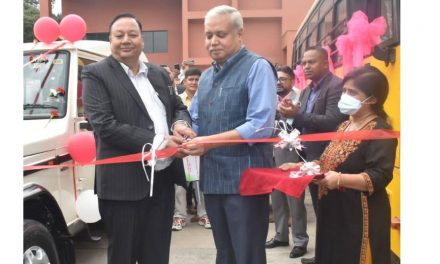-Keshav Nepal
India’s Minister for Power and Housing & Urban Affairs, Manohar Lal Khattar, recently wrapped up a two-day official visit to Nepal on April 22–23. While the visit may not have gained major global attention, its implications are far-reaching—especially in the context of climate change, energy needs, and regional cooperation. The growing partnership between Nepal and India is showing how clean energy can act as a strong diplomatic link in South Asia.
Hosted by Nepal’s Minister for Energy, Water Resources and Irrigation, Dipak Khadka, Khattar’s April 22–23 visit wasn’t just a protocol exercise. It was a decisive moment in transforming shared geography into shared prosperity, with energy—particularly clean energy—at the heart of the equation.
At the center of this transformation is the Arun III Hydroelectric Project, a 900-megawatt run-of-the-river venture in Sankhuwasabha district. With an Indian investment of NPR 104 billion (roughly USD 780 million), it’s being developed by India’s Sutlej Jal Vidyut Nigam (SJVN) and represents one of Nepal’s largest-ever infrastructure projects. But more than a construction feat, Arun III is a symbol of strategic trust—jointly inaugurated in 2018 by Prime Ministers Narendra Modi and KP Sharma Oli, and now approaching operationalization.
When Minister Khattar visited the project site in Makalu Rural Municipality, the message was clear: India is not just a neighbor; it is a partner in Nepal’s journey toward energy self-sufficiency and regional leadership. Once complete, the project will provide 21.9% of its output to Nepal free of cost, with the remaining electricity exported to India. This arrangement strengthens Nepal’s energy security and creates new revenue streams—critical for a nation with vast untapped hydropower potential.
But energy cooperation cannot thrive on generation alone—it requires infrastructure. Recognizing this, both nations signed agreements during the visit for two key cross-border transmission lines: Lamki-Bareli and Inaruwa-Purniya. These will knit together the power grids of Nepal’s Sudurpaschim and Koshi provinces with India’s Uttar Pradesh and Bihar, enabling smoother, more reliable electricity trade.
Of course, challenges remain. Minister Khattar candidly addressed long-standing issues like land acquisition and right-of-way for transmission lines—often the Achilles’ heel of major energy projects. But the willingness to openly discuss and resolve such issues reflects the maturity of Nepal-India relations today.
Importantly, the scope of cooperation is expanding beyond hydropower. Indian companies are increasingly involved in developing solar energy in Nepal—crucial for electrifying rural areas and reducing dependence on fossil fuels. There’s also growing interest in battery storage, green hydrogen, and regional power markets that could one day link Nepal’s clean energy to India, Bangladesh, and beyond.
All of this points to a broader shift: Nepal is no longer just a recipient of energy investment. It is emerging as a clean energy leader in South Asia, and India is embracing that vision. For India, supporting Nepal’s energy transition aligns with its own goals of sustainability, regional stability, and reducing carbon emissions. For Nepal, it’s a pathway to economic growth, energy independence, and regional influence.
And yet, there is more to this relationship than kilowatts and cables. Minister Khattar’s spiritual visits to Mustang and Pashupatinath Temple reminded us of the deep cultural and religious ties that bind these two nations. In South Asia, diplomacy is as much about temples and traditions as it is about treaties.
This blend of practical cooperation and cultural connection is the foundation for something powerful: a shared future built on clean energy. In a region too often defined by rivalry and distrust, Nepal and India are demonstrating that cooperation is not only possible—it is profitable, sustainable, and in the public interest.
But ambition must be matched with action. To fully realize this vision, both governments need to expedite bureaucratic processes, address project delays, and continue engaging communities affected by large-scale infrastructure. The private sector, too, must be encouraged through transparent policies and risk-sharing mechanisms.
If successful, the Nepal-India energy partnership could serve as a template for regional integration through clean energy—a blueprint for how nations can turn natural resources into mutual prosperity.
Minister Khattar’s visit may be over, but its impact will resonate for years to come. In the quiet flow of Arun’s waters and the hum of cross-border power lines, a new chapter is being written—not just for Nepal and India, but for all of South Asia.





